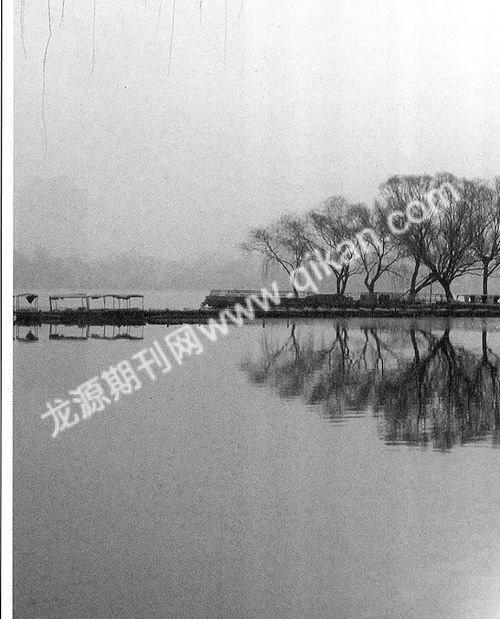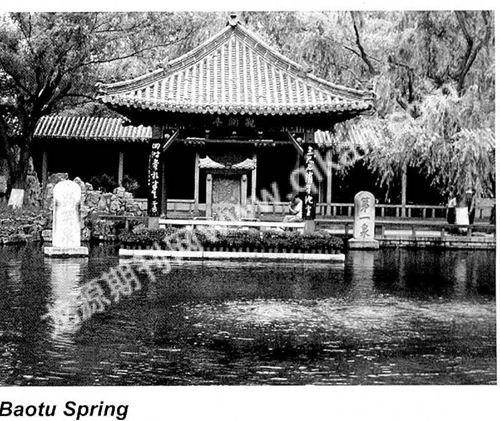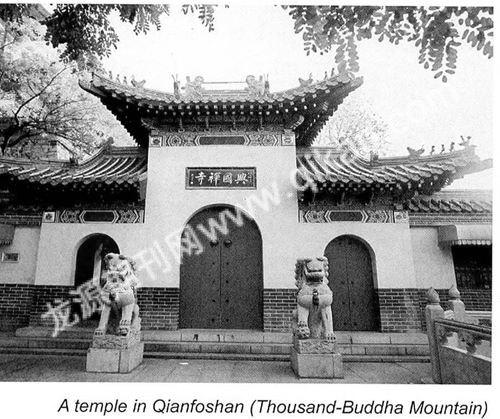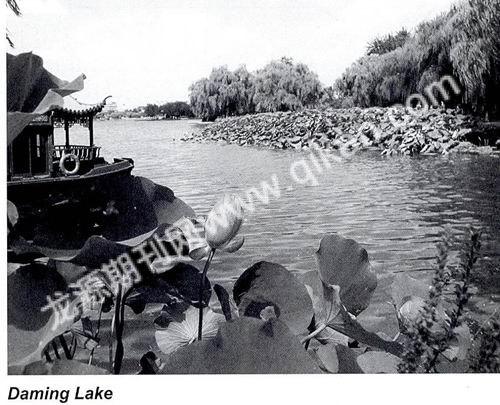Jinan,the City of Springs
2009-09-30
Jinan, the capital of Shandong Province, is located in the mid west of Shandong. It is called the “City of Springs” and is popular among tourists for its many springs.
Jinan is a historical city with a history of some 2000 years and is famed for its numerous relics. It is the cradle of the Longshan Relics Culture, the reputed prehistoric culture of China and is found in Longshan Town of Jinan, hence the name. In the area of Jinan, you will find far more than you would expect, the ancient Great Wall of the Qi State, a state of the Zhou Dynasty (770 BC – 221 BC), the colored sculptures of the Song Dynasty (960-1279) in the Lingyan Temple and so on.

It is a hospitable city and receives tourists from all over the world. Marco Polo once visited Jinan and left words of praise to this city. The Baotu Spring, Daming Lake and the Thousand Buddha Mountain decorate Jinan as a Garden City.
Daming Lake Park
Located in the center of Jinan City, Daming Lake Park is regarded as one of the three must-see tourist spots in Jinan (the other two are Baotu Spring Park and Thousand-Buddha Mountain). Daming Lake Park is famous for Daming Lake (also known as the Lake of Great Light) which is a natural lake formed from many springs. Characteristically unique is its constant water level, unaffected by heavy rains or drought.

Daming Lake Park covers a total area of 860,000 square meters (about 212 acres) of which the lake itself comprises of 460,000 square meters (about 113 acres). The six islands in Daming Lake contain flowers, trees and other plants flourishing amongst the various pavilions. The lake is a center of activity and one can find fish leaping near yachts and boats. In summer, lotuses bloom uninhibitedly filling half of the park with its fragrant scent. At the same time, willows circle the lake on three sides and swing with the breeze, a scene for which Daming Lake is famous. The centerpiece of the lake is a great man-made hectometer fountain built in 1985. The fountain has 103 injectors, and the main injector can spout water as high as 100 meters (about 328 feet) in all its majesty.

At the northwest bank of the lake stands Tie Xuan Temple (Tie Gong Temple). Built in 1792, it is a memorial to an official of the Ming Dynasty (1368-1644), Tie Xuan. He was a loyal military officer leading the army fighting for his emperor and local people, finally was killed cruelly after the failure. Admiring his heroic spirit and loyalty, the later generations built the temple. Tie Xuan Temple is a traditional courtyard in square shape. In the courtyard are Tie Xuan Temple, Small Canglang Pavilion, etc.

The largest Taoist Temple in Jinan City, Beiji Temple (North Pole Temple), also called North Temple is located at the northeast bank of Daming Lake. First built in the Yuan Dynasty (1271-1368), it has been restored many times. This group of constructions consists of the Bell and Drum Tower, the Front and Back Halls, and two other rooms. In the Front Hall, one will find the gilded statue of Zhenwu in the center (a Taoist god), and other 18 mud statues to represent the divinity of wind, thunder, etc.
Because of both the exceptionally natural and man-made scenery, many festivals and activities take place here every year, including the Temple Fair in Spring Festival, the New Year Flower Exhibition, the Lotus Exhibition, different folk festivals, and a wonderful Stone Exhibition.
Baotu Spring Park
Beautiful Baotu Spring Park is located in the centre of Jinan City, and it is here that you will find the Baotu Spring. In the past, the Baotu Spring only covered 4 mu (about two thirds of an acre). The park itself was originally established in 1956 and more recently has been extended to 158 mu (about 26 acres). This highly valued facility represents the symbol of Jinan City and is regarded as one of the three major places of interest in Jinan. This park is highly regarded as a well known scenic spot which makes an ideal location for admirers of wonderful natural springs, culture and various constructions.
Baotu Spring is located in the centre of Baotu Spring Park and is renowned as the best of the 72 springs in Jinan. Since ancient times, many famous poems and prose have been written relating to its unique beauty. According to experts research, this spring has a history of 3,543 years, dating back to the Shang Dynasty (16th –11th BC). The special geographical structure in Jinan creates the special Baotu Spring. The spring pool is rectangular in shape, stretching about 30 meters (about 98 feet) west to east and about 18 meters (about 59 feet) north to south. Spring water pours out from the underground limestone cave throughout the night and day, sometimes reaching its maximum of 240,000 cubic meters per day. When water bursts out from the three outlets, the spring creates thunderous sounds and sprays water jets. Sometimes water columns are created that reach as high as 26.49 meters (about 86.9 feet), making a real spectacle.
The spring retains its temperature at 18 degree Celsius (64.4 degree Fahrenheit) all year round. In cold winter, water mist rises and floats over the spring pool like clouds. Ancient pavilions and halls with colorful drawings and carvings reflect in the clear water creating a landscape virtually emulating paradise.
Pure in quality and mellow in taste, the spring water is ideal for drinking and making tea. Tea tasting is a favorite past time here. There is a saying here that you will spoil your Jinan tour if you do not drink the tea brewed with Baotu Spring water. To the east of the spring is the famous Wangheting Teahouse, where you can recreate the moment when past Emperors sat there, tasting tea and enjoying the beautiful scenic delights of Baotu Spring.
Whats more, the traditional and very popular Lantern Festival and Chrysanthemum Show are also held here every year, which greatly highlights the cultural significance and importance of this beautiful and very impressive scenic spot. Theres no doubt that visitors will be struck with this very memorable place.
Qianfoshan (Thousand-Buddha Mountain)
Lying 2.5 kilometers (1.55 miles) to the south of Jinan, Shandong Province, the Thousand-Buddha Mountain is one of the key points of interest in the city of Jinan. It is about 258 meters high (846 feet) ranging from east to west. It has been constructed into a park in1959 which occupies an area of about 166 hectare (140 acres).
The mountain was called Mt. Li in ancient times. However, in the early days of Sui Dynasty (581-618) a great many statues of Buddha were chiseled on the rocks of the mountain and the Thousand-Buddha Temple was built and soon became famous, so the name of the temple was to become that of the mountain. There are many scenic spots and historical relics distributed in the mountain. You can enjoy the beautiful sceneries all along the way wandering up either by foot or by bus.
The Thousand-Buddha Temple was renamed as Xingguo Temple after reparation during Tang Dynasty (618-907). It is located at half way of the mountain, leaning against the cliff on the south and overlooking the Jinan City on the north. There are the Daxiong Baodian, Kwan-yin Hall, the Laughing Buddha Hall and Duihua Kiosk distributed in the temple. Four seal characters carved on the cliff southwest of the temple is a celebrated stone inscription in the city of Jinan. The Lishan Courtyard, to the east of the temple, where you can see Confucianism, Daoism and Buddhism harmonize with each other in one courtyard. The Shun Temple, the Luban Temple, the Wenchang Pavilion and the Yilan Kiosk are to be found in it.
More than 130 statures of Buddha carved in the Sui Dynasty are bearded on the south side of the mountain. And the cliff holds four caves abreast from west to east, namely Longquan Cave, Jile Cave, Qianlou Cave and lvzu Cave.
The Wanfo Cave (about 500 meters long) was constructed in the north side of the mountain which draws elite of the four famous grottoes in China (the Mogao Caves, the Longmen Grottoes, the Yungang Caves and the Maiji Caves). About 23,000 pieces of statues in designs of Buddha, Bodhisattva, Disciples and Guardian Kings, etc. fully reveal the superb workmanship of sculpture in the Northern Wei Dynasty (386-534), the Tang Dynasty and the Song Dynasty (960-1279).
Besides, the famous Shandong Revolutionary Martyrs Cemetery for Revolution of 1911 is situated in the east side of the mountain. Built in 1934, the cemetery was put under the provincial protection in 1979.
The Park of Thousand-Buddha Mountain was listed as one of the Seven Beauty Spots of Shandong Province in1995. Great efforts have been made to add many scenic spots such as water pull, gardens and ropeways, etc. in recent years.
Shandong Provincial Museum
At the foot of the Thousand Buddha Hill (Qian Fo Shan), Shandong Provincial Museum covers the nature and history of the ancient Qi and Lu States.
Featured among the 140,000 pieces of historic relics are treasures from the Dawenkou and Longshan Cultures. Included from the Han Dynasty (206 BC-220 AD) are oracles, seals, and bamboo slips for writing, stone sculptures, calligraphy and paintings, and precious books. From intricate bronze wares, tourists can learn the customs of various dynasties, such as the worship of Shang Dynasty gods, ancestor worship in the Zhou Dynasty, and Han Dynasty human relationships.
The Qi and Lu Treasures showcase 212 pieces of cultural relics, including pottery, porcelain, jade, craftworks and bronze ware. Egg shell black pottery is the masterpiece of the Longshan Culture over 4,000 years ago. The shining black pottery is exquisite and thin as an egg shell.
The Stone Sculpture Art Exhibition, which includes stone sculptures, steles, and tombstones, occupies a vital place in the museum. The decorative stone sculptures of the Han Dynasty integrate painting and sculpture. The style first appeared at the end of the West Han Dynasty (206 BC -24 AD) and vanished at the end of the East Han Dynasty (25-220 AD). This art is closely related to the lavish burial customs in well-developed areas during the Han Dynasty.
In the natural collections, specimens cover 200 species. Among them, fossils of trilobite, the Taishan swallow, the dinosaur, and so on, influence knowledge in ancient biologic and geographic fields.
A visit to the museum is like a dialogue with history, revealing the wonders of Qi-Lu Culture.
Note on Qi and Lu Culture:
Shandong Province is called the State of Qi and Lu, both ancient states.
Qi State with its capital in todays Linzi, Shandong, was founded in 1122 BC and was one of the most prosperous states at that time until 211 BC when it was conquered by Emperor Qinshihuang.
Lu State was set up during the Western Zhou Dynasty (1100-771 BC), and was conquered by Chu during the Warring States (475-221 BC), playing a vital role in politics and culture. It was due to the Lu State that Shandong was named Lu for short.
